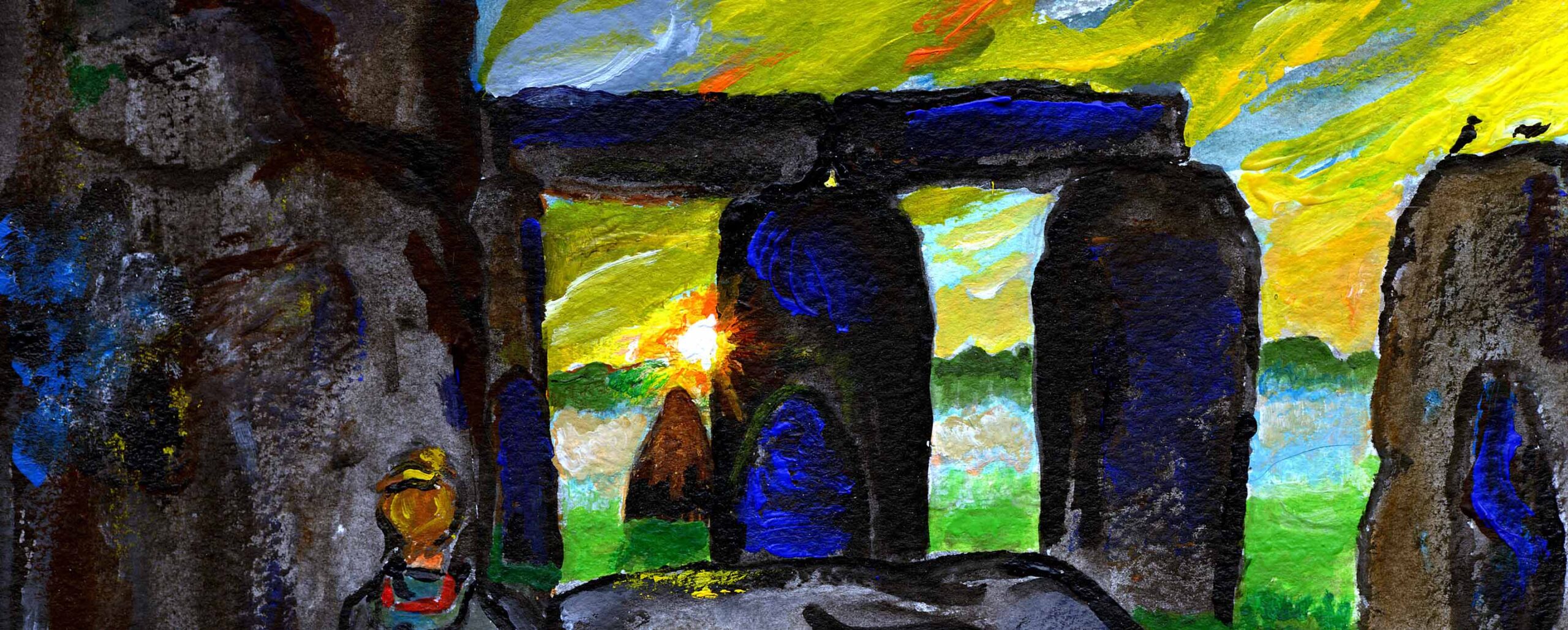Here is the sky scene this evening – with a startling addition.

We see the stars and planets we’ve been seeing for a while – Saturn is getting lower toward the sunset. But what are these gigantic globes that seem to be chasing us along the ecliptic, the nearest of them appearing larger than many Full Moons?
They are past Earths. That is, they are our Earth where it was, 10, 20, 30, 40, and so on days back into the past.
They serve to show how Earth hurtles around its orbit. The ecliptic is just a line on a chart; we can mentally paint it on the celestial sphere, but it doesn’t curve in toward us. So we forget to see it as the series of points where the Earth was at various dates. The globes serve to make the orbit more vivid, as if it were a circular rail around the Sun, along which Earth is sliding like a bead along a string.
Actually the past Earths are exaggerated 200 times in size, otherwise they would be too small to show. The Earth even as little as 10 days back was nearly 60 million miles away – nearly 250 times farther from us than the Moon.
The nearest past-Earth has a D-shaped sunlit face because it is almost at 90 degrees from the Sun, just as the Moon appears D-shaped at First Quarter. That Earth is behind us; the Moon at First Quarter is crossing our orbit behind us.
You can see that this nearest Earth is just short of the point marked “antapex of Earth’s way,” which is the direction straight backward from where we are now.
The past-Earths would look more like Earths if I had drawn the equator on them, showing their tilt, but I haven’t yet figured out how to program this.
The nearest past-Earth may not look as if the trail it is on is curving in strongly enough to hit us. The trail would come in to hit the equator, at the present Earth’s rearmost point. If we were to draw an Earth on the same scale only 5 days ago, it would fill most of the sky; only one day ago, and we would be deep inside it.
There is a past-Earth colored brownish-orange; why? It is 60 days ago; it’s the one that is nearest to where Earth was at the September 23 equinox.
And there is another, down near the horizon, colored yellow. It’s the past-Earth that is nearest to where we were at the June solstice.
The series of past-Earths continues below the horizon (they are colored pink – actually, magenta). They so this to show how the girdle of Earth-positions goes completely around behind the Sun.
And here is the eastern scene tomorrow morning, when we will be looking ahead along Earth’s line of travel:

These are the future-Earths. They are at the places along the ecliptic where we will be, 10, 20, 30 and so on days ahead. The nearest of them is only just left of the “EDOT,” Earth’s present direction of travel.
The future-Earth 30 days ahead is colored blue: it is the one that’s nearest to where Earth will be at the December 21 solstice.
What caused me to think of plotting the past and future Earth’s was an idea from Daniel Cummings (creator of the Moon Hat, Soft Earth, Sun Tracker, and Star Spot, and other aides to the imagination). His idea is of a “visible Earth orbit,” and he asked me whether I had some software that could plot its appearance in the sky. At first I had trouble understanding what he meant, because he described it in terms of a sparkly dust trail, the Moon’s phases, the meridian, setting-points on the horizon – then I understood.
__________
DIAGRAMS in this post were made with precision but had to be inserted in another format. You may be able to enlarge them on your monitor.
One way: right-click, and from the drop-down list choose “View image”.
Or from that list choose “Copy image”, then put it on your desktop, then open it.sun.
The past-Earths would look more like Earths if I had drawn the equator on them, showing their tilt, but I haven’t yet figured out how to program this.
__________
DIAGRAMS in this post were made with precision but had to be inserted in another format. You may be able to enlarge them on your monitor. One way: right-click, and from the drop-down list choose “View image” Or from that list choose “Copy image”, then put it on your desktop, then open it. I would welcome learning of any other methods.
This weblog asserts its right to be about astronomy or anything under the sun.
I would welcome learning of any other methods.

Hi Guy! Thanks for sharing this amazing visualization – it really helps to augment the view of the sky to have these images plotted in the sky to their precise locations. My starting point for these flights of imagination (and my product development) is to try to figure out how to “see” large scale structures of the solar system and translate them into techniques or mnemonics.
This is wonderful! I love seeing unique visualizations of celestial movements. Thank you for putting this together.
Hello Guy,
Whatever you did to get these images, keep doing it. I put the arrow on the image, clicked and held, and moved the image to my desktop (MacAir). I didn’t need to increase size on either image. Nice work.
Yours, Joseph